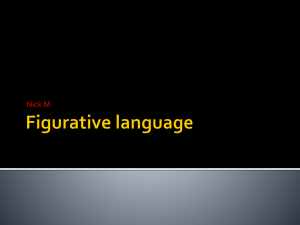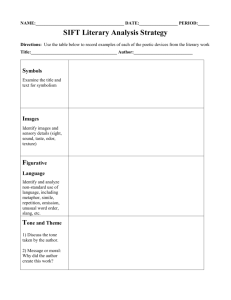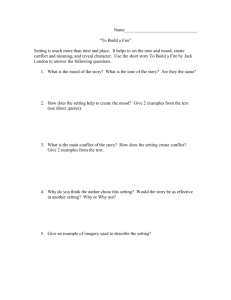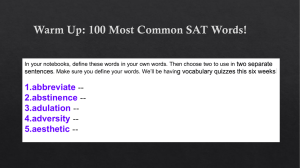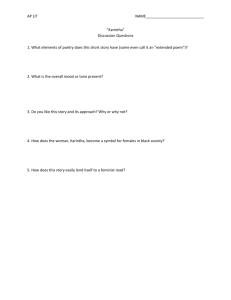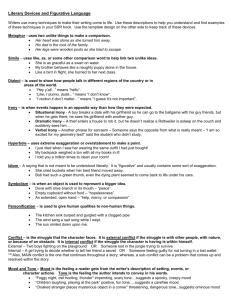File
advertisement
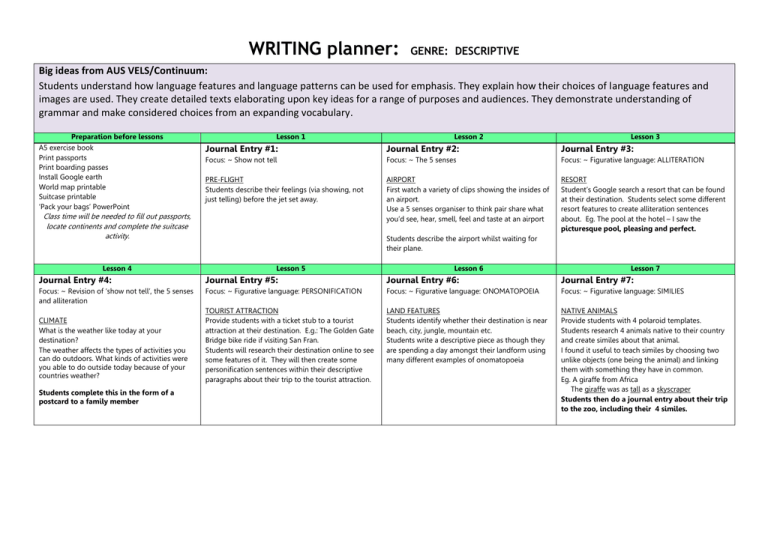
WRITING planner: GENRE: DESCRIPTIVE Big ideas from AUS VELS/Continuum: Students understand how language features and language patterns can be used for emphasis. They explain how their choices of language features and images are used. They create detailed texts elaborating upon key ideas for a range of purposes and audiences. They demonstrate understanding of grammar and make considered choices from an expanding vocabulary. Preparation before lessons A5 exercise book Print passports Print boarding passes Install Google earth World map printable Suitcase printable ‘Pack your bags’ PowerPoint Lesson 1 Lesson 3 Journal Entry #2: Journal Entry #3: Focus: ~ Show not tell Focus: ~ The 5 senses Focus: ~ Figurative language: ALLITERATION PRE-FLIGHT Students describe their feelings (via showing, not just telling) before the jet set away. AIRPORT First watch a variety of clips showing the insides of an airport. Use a 5 senses organiser to think pair share what you’d see, hear, smell, feel and taste at an airport RESORT Student’s Google search a resort that can be found at their destination. Students select some different resort features to create alliteration sentences about. Eg. The pool at the hotel – I saw the picturesque pool, pleasing and perfect. Class time will be needed to fill out passports, locate continents and complete the suitcase activity. Lesson 4 Lesson 2 Journal Entry #1: Students describe the airport whilst waiting for their plane. Lesson 5 Lesson 6 Lesson 7 Journal Entry #4: Journal Entry #5: Journal Entry #6: Journal Entry #7: Focus: ~ Revision of ‘show not tell’, the 5 senses and alliteration Focus: ~ Figurative language: PERSONIFICATION Focus: ~ Figurative language: ONOMATOPOEIA Focus: ~ Figurative language: SIMILIES TOURIST ATTRACTION Provide students with a ticket stub to a tourist attraction at their destination. E.g.: The Golden Gate Bridge bike ride if visiting San Fran. Students will research their destination online to see some features of it. They will then create some personification sentences within their descriptive paragraphs about their trip to the tourist attraction. LAND FEATURES Students identify whether their destination is near beach, city, jungle, mountain etc. Students write a descriptive piece as though they are spending a day amongst their landform using many different examples of onomatopoeia NATIVE ANIMALS Provide students with 4 polaroid templates. Students research 4 animals native to their country and create similes about that animal. I found it useful to teach similes by choosing two unlike objects (one being the animal) and linking them with something they have in common. Eg. A giraffe from Africa The giraffe was as tall as a skyscraper Students then do a journal entry about their trip to the zoo, including their 4 similes. CLIMATE What is the weather like today at your destination? The weather affects the types of activities you can do outdoors. What kinds of activities were you able to do outside today because of your countries weather? Students complete this in the form of a postcard to a family member Lesson 8 Lesson 9 Lesson 10 Lesson 11 Journal Entry #8: Journal Entry #9: Journal Entry #10: Journal Entry #11: Focus: ~ Figurative language: HYPOBOLES http://www.ducksters.com/geography/ Focus: ~ Figurative language: IDIOMS Focus: ~ Figurative language: ONOMATOPPOEIA Focus: ~ Figurative language: METAPHORS SIGHT SEEING the CITY Students will take a trip around their town using public transport. Students will have a tour guide accompanying them, who uses idioms throughout their tour explanations. FREE WRITE JOURNAL ENTRY After brainstorming as many onomatopoeia words as possible, students will pick one that they plan on using within todays writing. PEOPLE Watch the BrainPop on metaphors and determine the difference between similes and metaphors.. HISTORY Students use the above website to find the relevant page on their country. They need to scroll down and copy and paste the ‘brief history’ section of their country. Students use this brief history text to write a journal entry on their visit to the local museum. Students need to insert hyperboles as many times as possible. E.g. Christopher Columbus landed at Cuba in1492 and claimed the land for Spain. His smile was a mile wide Students are given a list of 10 idioms that their tour guide uses. Task 1: Work with a buddy to try and identify what the idiom means Task 2: Students write a journal entry describing their trip (what they saw, did, ate etc..) including when and how the tour guide used the idioms. (Students should try to be as factual as possible with their trip so may need to research their city’s points of interest) Lesson 12 NOT A TRAVEL JOURNAL ENTRY Determine the difference between mood and tone: Use the mood and tone posters to refer to. Put simply, Tone = the authors attitude Mood = the readers feelings Watch the mood and tone brainpop to assist with student understanding. Students prepare themselves to listen to 10 snippets of music. Play each song one at a time; students draw a picture to match their thoughts when listening to each composition with one or more words that they feel when listening. Lesson 13 Students first need to create their artwork on A5 paper. E.g. Students free write about any part of their travels ensuring they incorporate their onomatopoeia word throughout. Lesson 14 Journal Entry #12: Journal Entry #13: Focus: ~ Figurative language: MOOD Focus: ~ Figurative language: TONE Before beginning, complete the ‘mood: feelings and colour’ activity sheet and the ‘creating mood using weather’ powerpoint. Show the two examples of you tube clips that clearly show the difference with creating tone. 1.http://www.youtube.com/watch?v=fuWf9fP -A-U 2.http://www.youtube.com/watch?v=2T5_0A GdFic Discuss the tone in both. FLIGHT HOME Students sit back, relax and enjoy their flight home. Using weather description (as they look out their window) and colour words, students portray their trip home on the plane. Students put their earphones in and program their iPod to play 3 songs that complement their mood throughout their trip. TRIP REFLECTION Provide students with words describing tone. Such as boring, sarcastic, cheerful etc. (See list if you are unsure of tone words) Students select one that they will try to portray in their journal. They will reflect on their whole trip whilst trying to portray their chosen tone. Model metaphors using the learning group teachers. Students will be preparing to leave their country and in doing so, create a metaphor for the following people: Gift shop cashier Hotel manager Neighbour of room Friend they met at their resort Taxi driver Security guard at the airport Students create a journal entry which involves the above people, ensuring they have included metaphors within their writing. http://www.youtube.com/watch?v=g5xAJG lOOe8 How did the composer create these feelings? Through tone. - In music it’s created through instruments, tempo and volume. In movies it’s created through dialogue, editing, music and lighting. In writing it’s created through word choice and vivid imagery. Additional task: Students choose one of the songs to use as a source of inspiration which matches the tone of their trip i.e. The music is the soundtrack to their trip.
